Dedicated to sifting through the detritus accumulated in my studio life, Studio Debris
 Subscribe here to the STUDIO DEBRIS rss feed via the service of your choice.
Subscribe here to the STUDIO DEBRIS rss feed via the service of your choice.
Sculptors Imi Hwangbo and Jae Ko both share a Korean heritage, and a love for process-intensive, sculptural works in paper. While their ancestry and materials may follow a similar path, viewed concurrently, their work offers surprising contrasts in the show Cut, Folded, Dyed & Glued, now on view at Brown University’s David Winton Bell Gallery.
I attended the opening reception on January 25th, not knowing quite what to expect, but as a mixed-media artist and paper fanatic in my own right, was predisposed by the press release to favor the precise, geometric flawlessness of Athens, GA based Imi Hwangbo.
Hwangbo, a Professor of Sculpture at the University of Georgia, Athens, creates breathtakingly complex geometric work on translucent Mylar, using a hybrid process that engages the didactic powers of computer technology and the human hand.


With a nod to traditional Korean decorative arts, often the realm of Korean women and therefore viewed as subordinate, Hwangbo holds the power to borrow freely from their various forms without adhering strictly to tradition. In this way she elevates to a sublime position designs and colors adapted from traditional hanbok (clothing) and pojagi (cloths used for wrapping, covering, and carrying objects).
Viewed in person, I was surprised and underwhelmed by the relatively small scale of the work in relation to the space. While at first glance the delicate, yet intricate layered Mylar pieces shrunk against the wall in the dimly lit gallery, I eventually found enlightenment in the most miniscule representatives of the group, Sylph (2007) and Peri (2007).

Like the rest of the Hwangbo’s work, these modestly sized wall-relief sculptures are constructed from many layers of hand-cut Mylar, first patterned with geometric shapes digitally rendered in archival ink, then painstakingly hand-cut to achieve symmetrical depth. What set these two pieces apart from the others in the series was artist’s success at creating wall-relief sculpture un-encumbered by the visual limits of the supporting structure. In Sylph and Peri, this is due to the fact that the limits are left with an asymmetrical edge, whereas many of the other works in the show appear simply as rectangular hanging pieces with designs existing within their borders. By leaving the 5-pointed, floral design to toe the line between growth and decay, the backing support of these pieces fades to invisibility and draws the eye into dazzling depths of complex, precise, yet organic layering.

I was enchanted by Jae Ko’s installation of larger, monochromatic pieces molded from layer upon layer of adding machine paper. Stemming from two distinct bodies of work in the artist’s career, the high relief wall friezes and modular floor sculptures were created by layering, twisting and soaking the ribbons of paper in ink. The results are otherworldly, as the simple stripe of adding machine paper is transformed into solid whorls and powdery whispers.
Untitled (JK328) (2005), a formidable black wall frieze, achieves its charred color via a thorough soaking in black sumi ink. Nine, rounded rectangular shapes are packed tightly together, the sharp edges of the paper facing out towards the viewer. Looking closely, one can see a hint of a white interior, similar in quality to a book that has been burnt in a fire. Stepping back from the wall, the shapes take on an evocative, font-like quality, like a shadow of a highly stylized graffiti tag.
A companion piece, also Untitled (JK327) (2005), mirrors its partner across the gallery. Slightly more symmetrical, with an even eight sub-shapes, this piece has a strange, pin-tucked upholstery aspect that seems under-realized compared to the former.

On the floor space spanning the two, lay an array of joyful whorls and wheels. Like cochlea, or the workings of an imaginary phonograph, these modular pieces were also created from endlessly wrapped rolls of adding tape. Unlike the wall friezes, these pieces were sealed from toe to tip with calligraphy ink, resulting in a shiny, almost plastic surface in alluring lipstick red. They invite circumambulation and handling, and I love the way the bright color pops against the polished black floors of the gallery. Although I wouldn’t dare, I imagine inventing a game where these twisted spools could be rolled across the floor.

The evocative sculptural works of these meticulous visionaries share the stark, hushed space of the David Winton Bell Gallery until March 5th. You can find the gallery at: Brown University, List Art Center, 64 College Street, Providence, RI 02912
Recommended local dining: Kabob & Curry, Andreas
Fat Tuesday is one tradition that the folks in New Orleans maintain in order to show some love to February. It's long been my least favored month, having been host to a number of nasty breakups, bouts of illness, vitamin D deficiency, and icy spills. This year, I decided to give February the benefit of the doubt. In order to guarantee it a special place in my heart, my fella and I scheduled our wedding for February 2nd (sharing the calendar with the pagan holiday of Imbolc and the more widely known Groundhog Day). Wouldn't you know it, but the sun actually came out for the whole weekend! Punxutawny Phil's furry reaction? Less favorable than we'd prefer.
That said, expect a flurry of activity from me now that the daunting task list of my nuptuals has passed. As a compliment to my review contributions to the upcoming issues of Boston's Artscope Magazine, I will be covering art shows and events local to Providence right here on Studio Debris. Stay tuned, as I have a couple of tasty shows to tell you about right here in the queue.
If you have any suggestions for Providence arts coverage, feel free to send them along via my contact form.
* Special Note: if you want to be considered for full editorial coverage in Artscope, please provide press releases and show information at least 2 months in advance of the show's opening date. Submission does not guarantee coverage in either Studio Debris or Artscope Magazine.
For a small, manageable city, Providence enjoys a disproportionate amount of creative energy. Generated by its powerful arts community, and constantly refreshed by an influx of creative students; the programming, entrepreneurship, venues and activism rival that of its larger neighboring city to the north.
Marilyn and I mused upon this over inspirational $4 craft beers in the window of AS220’s Taqueria Pacifica last night. A vaudeville-style review twittered and honked away in the adjacent room, backed by golden stage light and red velvet curtain, while restless, leg-warmer and denim-clad creatives between ages 18 and 80 flitted and slouched between the bar and performance.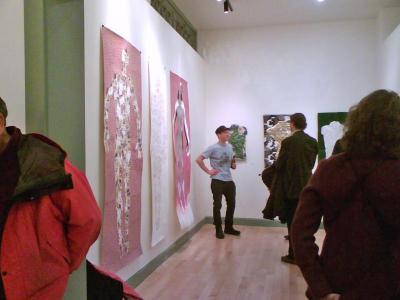
Our pit stop came after the opening reception of artist Anna Shapiro’s solo show just around the corner at AS220's Project Space, located in the recently renovated Dreyfus building. Native of NYC, and long-time resident of Boston (that larger, neighboring city to the north of which I’m also native), Shapiro entered the Providence art scene not too many years ago. Now well known about town as Director of the year-old alternative arts space Firehouse 13, Shapiro also exercises her mixed-media muscle for the Steelyard’s public art commissions, and maintains her own studio work in paper, fibers, sculpture, installation and performance.
Shapiro’s solo show, in the main room of the gallery, is entitled Piece Work. A play on words as well as a point, she refers to the late 19th century practice of a seamstress, taking on sewing assignments “per piece”, and receiving payment as such. With so many balls in the air, for a mixed-media artist and arts administrator, to sit down and create en masse in the personal solitude of studio work can seem a challenge. And so, she takes each piece on as a personal assignment, letting the materials at hand inform her process.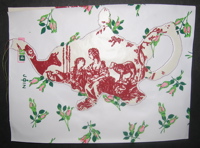
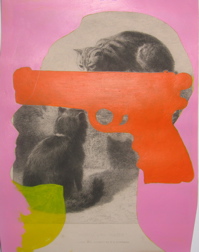
Still, this body of work, comprised of found papers, paint, fibers, bullets, feathers, fabric and other detritus shows a cohesive thread, despite the framework of fragmentation. A repeated, un-gendered silhouette finds it’s way into many of the pieces – and where he/she does not appear, a teapot stands in. In a way, there echoes a question posed to gender and place in the broader scheme of things. Mirrors, maps and tarot cards suggest an implied question (that sits in the minds of many of my 30-40 year old contemporaries).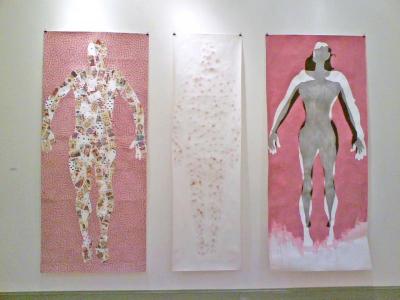
The strongest pieces in the show confront the visitor entering the main gallery. Chance/Galaxy/Overlay, a triptych, features a life-sized silhouette interpreted in three distinct views. The first silhouette, Chance, is carved from a sea of traditional, plaid playing cards scattered face down over a large sheet of backing paper. Implied by the muted primary hues of a tarot card deck, the body void hangs in nervous balance at the center of the composition. Galaxy, a fittingly ethereal figurative drawing, upon close examination is built up by hundreds of carefully planted lipstick kisses. Each red or pink kiss, doubling uncomfortably as a bruise or wound, is tied to its flanking sisters by a red thread. The result is a map of the human body (or heart?) reminiscent of an antique anatomical diagram. Overlay, the final silhouette of the triptych, serves a more traditional, painterly point-of-view to the art of figurative silhouette, and acts more as a shadow to it’s partners’ bold questions.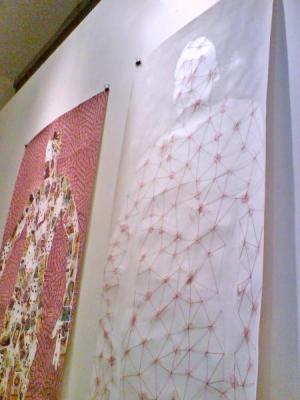
Anna’s strength is with applied mixed-media, and this continues on the adjacent wall with another triptych of sculptural torsos rendered in a dizzying array of materials. My favorite piece of the show, Torso (Feather and Floral), blooms out of a fabulous, gaudy swatch of vintage upholstery fabric, quilted to imply musculature. A swath of emerald green plumage erupts from the solar plexus, and restrained by plastic, defines an elegant contrapposto. Torso is a drag queen runway diva, and she is fabulous. 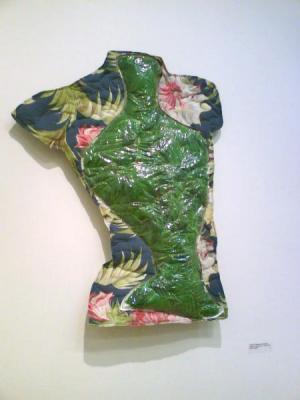
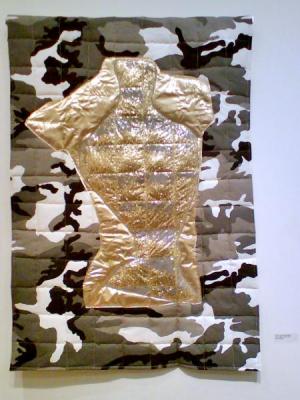
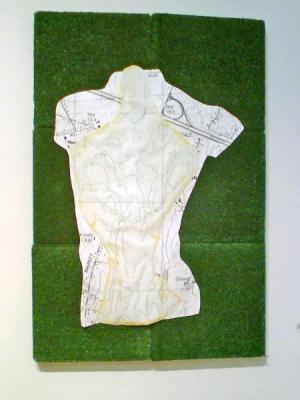
You can catch Piece Work by Anna Shapiro at the AS220 Project Space, located at 93 Mathewson Street, Providence, RI 02906. The show runs through January 27th, 2008.
While you’re there, visit Infinitiesimal Fortitudes, a plast-tastic video installation by Richard Goulis.
Recommended local dining: Local 121, Taqueria Pacifica, Trinity Brewhouse